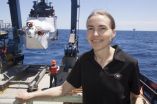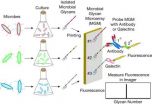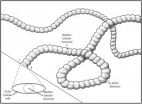(Press-News.org) Athens, Ga. – The 2010 Deepwater Horizon blowout discharged roughly five million gallons of oil and up to 500,000 tons of natural gas into Gulf of Mexico offshore waters over a period of 84 days. In the face of a seemingly insurmountable cleanup effort, many were relieved by reports following the disaster that naturally-occurring microbes had consumed much of the gas and oil.
Now, a team of researchers led by University of Georgia marine scientists have published a paper in the journal Nature Geoscience that questions this conclusion and provides evidence that microbes may not be capable of removing contaminants as quickly and easily as once thought.
"Most of the gas injected into the Gulf was methane, a potent greenhouse gas that contributes to global climate change, so we were naturally concerned that this potent greenhouse gas could escape into the atmosphere," said Samantha Joye, senior author of the paper, director of the study and professor of marine science in UGA's Franklin College of Arts and Sciences. "Many assumed that methane-oxidizing microbes would simply consume the methane efficiently, but our data suggests that this isn't what happened."
Joye and colleagues from other universities and government organizations measured methane concentrations and the activity of methane-consuming bacteria for ten months, starting before the blowout with collection of an invaluable set of pre-discharge samples taken in March 2010.
The abundance of methane in the water allowed the bacteria that feed on the gas to flourish in the first two months immediately following the blowout, but their activity levels dropped abruptly despite the fact that methane was still being released from the wellhead.
This new data suggests the sudden drop in bacterial activity was not due to an absence of methane, but a host of environmental, physiological, and physical constraints that made it difficult or impossible for bacteria to consume methane effectively.
"For these bacteria to work efficiently, they need unlimited access to nutrients like inorganic nitrogen and trace metals, but they also need elevated methane levels to persist long enough to support high rates of consumption," Joye said. "The bacteria in the Gulf were probably able to consume about half of the methane released, but we hypothesize that an absence of essential nutrients and the dispersal of gas throughout the water column prevented complete consumption of the discharged methane."
Joye insists that while her group's conclusions differ from those presented in previous studies, there is no serious conflict between their analyses.
"The issue here was short-term sampling versus long-term time series sampling," she said. "I hope our paper clearly relays the message that long-term sampling is the only way to capture the evolution of a natural system as it responds to large perturbations like oil well blowouts or any other abrupt methane release."
Ultimately, scientists need to better understand the behavior of these microbes so that they may better gauge the environmental impacts of future accidents and methane releases due to climate change, she said.
"It's only a matter of time before we face another serious incident like Deepwater Horizon," Joye said. "The key is understanding the things that regulate how fast bacteria can consume methane, and that will give us insight into the ultimate fate of this potent greenhouse gas in our oceans."
INFORMATION:
Other authors on the paper include M. Crespo Medina, C.D. Meile, K.S. Hunter and J.J. Battles, University of Georgia; A-R. Diercks, V. L. Asper, A.M. Shiller and D-J. Joung, University of Southern Mississippi; V. J. Orphan and P. L. Tavormina, California Institute of Technology; L. M. Nigro, University of North Carolina, Chapel Hill; J.P. Chanton, Florida State University; R.M.W. Amon, Texas A&M University; A. Bracco and J.P. Montoya, Georgia Institute of Technology; T.A. Villareal, The University of Texas, Austin; A.M. Wood, NOAA Atlantic Oceanographic and Meteorological Laboratory.
Support for this study includes funding from the National Oceanic and Atmospheric Administration, the U.S. Department of Energy, the National Science Foundation and the Gulf of Mexico Research Initiative.
The full article is available online at http://dx.doi.org/10.1038/ngeo2156.
UGA research examines fate of methane following the Deepwater Horizon spill
2014-05-11
ELSE PRESS RELEASES FROM THIS DATE:
Galectins direct immunity against bacteria that employ camouflage
2014-05-11
Our bodies produce a family of proteins that recognize and kill bacteria whose carbohydrate coatings resemble those of our own cells too closely, scientists have discovered.
Called galectins, these proteins recognize carbohydrates from a broad range of disease-causing bacteria, and could potentially be deployed as antibiotics to treat certain infections. The results are scheduled for publication in Nature Chemical Biology.
Researchers at Emory University School of Medicine made the discovery with the aid of glass slides coated with an array of over 300 different glycans ...
Study finds patients AFib at higher risk of dementia when meds out of range
2014-05-10
A new study by researchers at the Intermountain Medical Center Heart Institute in Salt Lake City has found that atrial fibrillation patients who are on blood thinning medications are at higher risk of developing dementia if their doses are not in the optimal recommended range.
The study of more than 2,600 AFib patients found they are significantly more likely to develop dementia when using medicines to prevent blood clots, such as warfarin, when their dosing is too high or too low for an extended period of time.
Findings from the study will be presented at the 2014 ...
Bee biodiversity boosts crop yields
2014-05-10
Research from North Carolina State University shows that blueberries produce more seeds and larger berries if they are visited by more diverse bee species, allowing farmers to harvest significantly more pounds of fruit per acre.
"We wanted to understand the functional role of diversity," says Dr. Hannah Burrack, an associate professor of entomology at NC State and co-author of a paper on the research. "And we found that there is a quantifiable benefit of having a lot of different types of bees pollinating a crop."
The researchers looked at blueberries in North Carolina ...
Scientists find gene behind a highly prevalent facial anomaly
2014-05-10
CAMBRIDGE, Mass. (May 9, 2014) – Whitehead Institute scientists have identified a genetic cause of a facial disorder known as hemifacial microsomia (HFM). The researchers find that duplication of the gene OTX2 induces HFM, the second-most common facial anomaly after cleft lip and palate.
HFM affects approximately one in 3,500 births. While some cases appear to run in families, no gene had been found to be causative. That is until Whitehead Fellow Yaniv Erlich and his lab set out to do just that. Their work is described in this week's issue of the journal PLOS ONE.
Patients ...
Cardiac screening test may help determine who should take aspirin to prevent heart attack
2014-05-09
MINNEAPOLIS, MN – May 6, 2014 – For over 30 years, aspirin has been known to prevent heart attacks and strokes, but who exactly should take a daily aspirin remains unclear. New research published today in Circulation: Cardiovascular Quality and Outcomes shows that your coronary artery calcium (CAC) score, a measurement of plaque in the arteries that feed the heart, may help determine whether or not you are a good candidate for aspirin.
"Many heart attacks and strokes occur in individuals who do not appear to be at high risk," states lead author, Michael D Miedema, MD, ...
NASA's TRMM Satellite see spring storms hit the US Great Plains
2014-05-09
VIDEO:
The TRMM satellite flew above tornado spawning thunderstorms in the southern United States on May 9, 2014 at 0115 UTC. This simulated 3-D TRMM animation shows the location of intense...
Click here for more information.
The Tropical Rainfall Measuring Mission or TRMM satellite captured rainfall and cloud height information about the powerful thunderstorms and severe weather that affected the Great Plains over May 8 and 9.
Severe weather extended from Minnesota to southern ...
Plugging leaky blood vessels to save vision
2014-05-09
TORONTO – A new drug approach has been developed for safer clean-up of deformed blood vessels in the eye by a research team at the Lunenfeld-Tanenbaum Research Institute, Mount Sinai Hospital in Toronto.
The growth of malformed blood vessels that can burst is a leading cause of vision loss in North America. Retinopathy and retina degeneration are associated with premature birth, with diabetes, and with increasing age.
Research just published by Dr. Andras Nagy and co-authors shows both safety and effectiveness in their bioengineered compound when treating retinopathy ...
Paleontologists discover new fossil organism
2014-05-09
RIVERSIDE, Calif. — Scientists at the University of California, Riverside have discovered a fossil of a newly discovered organism from the "Ediacara Biota" — a group of organisms that occurred in the Ediacaran period of geologic time.
Named Plexus ricei and resembling a curving tube, the organism resided on the Ediacaran seafloor. Plexus ricei individuals ranged in size from 5 to 80 centimeters long and 5 to 20 millimeters wide. Along with the rest of the Ediacara Biota, it evolved around 575 million years ago and disappeared from the fossil record around 540 million ...
Discovery links rare, childhood neurodegenerative diseases to common problem in DNA repair
2014-05-09
(MEMPHIS, Tenn. – May 9, 2014) St. Jude Children's Research Hospital scientists studying two rare, inherited childhood neurodegenerative disorders have identified a new, possibly common source of DNA damage that may play a role in other neurodegenerative diseases, cancer and aging. The findings appear in the current issue of the scientific journal Nature Neuroscience.
Researchers showed for the first time that an enzyme required for normal DNA functioning causes DNA damage in the developing brain. DNA is the molecule found in nearly every cell that carries the instructions ...
Longevity gene may boost brain power
2014-05-09
Scientists showed that people who have a variant of a longevity gene, called KLOTHO, have improved brain skills such as thinking, learning and memory regardless of their age, sex, or whether they have a genetic risk factor for Alzheimer's disease. Increasing KLOTHO gene levels in mice made them smarter, possibly by increasing the strength of connections between nerve cells in the brain. The study was partly funded by the National Institutes of Health.
"This could be a major step toward helping millions around the world who are suffering from Alzheimer's disease and ...




